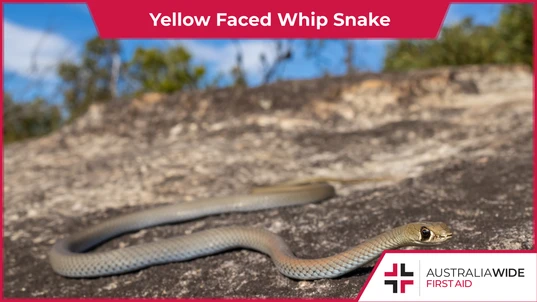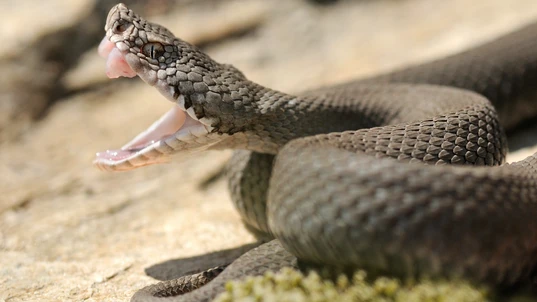Brisbane's Yellow Faced Whip Snake

Bites and Stings

The Yellow faced whip snake is common throughout the greater Brisbane area. A shy and nervous species, the Yellow faced whip will bite when threatened, and its venom can cause severe symptoms like localised pain and swelling.
The Yellow faced whip snake loves being out and about sunbaking during the summer months, particularly throughout Brisbane and surrounds. While found all throughout Australia, it is common in Brisbane during summer and is often mistaken for the Eastern brown snake. This quick moving, whip-like snake is shy and will only bite unless provoked or cornered. The venom of a Yellow faced whip snake can give a painful bite with localised swelling. If you are bitten by a snake, seek medical attention. Instead of trying to capture or kill it, try to take a photo for further identification by a professional. Always assume it is venomous. Read on to learn more about the alert and flighty Yellow faced whip snake. We also cover Yellow faced whip and other snake bites in the following Brisbane first aid courses: a general first aid course or a specialised one for educators or support staff.Appearance
Pale grey to brown in colour, the Yellow faced whip snake has a reddish colouring on its head and sometimes its tail. The Yellow faced whip is characterised by a dark comma-shaped streak that sits over its eyes. This comma-shaped streak is framed by distinct pale cream or yellow lines. This gives the illusion of a tear drop. The Yellow faced whip’s belly, meanwhile, is an olive green to yellow colour. The Yellow faced whip grows to about 65 - 70cm. In Brisbane, local species have been recorded to reach around 80cm.Habitat
The Yellow faced whip is found in a wide range of habitats, including open forests, farmland and suburban gardens. It enjoys sheltering in timber piles and under rocks, sheets of iron, and other man-made covers. Active during the day (diurnal) the Yellow faced whip feeds on lizards and their eggs, frogs and other snakes. They are not always lone creatures and are sometimes found sheltering in crevices together.Habits
This species of snake is swift, alert and anxious - darting in and out of shrubs, between rock walls or timber piles - making you wonder if you ever really saw it to begin with. Their sharp eyesight gives them the ability to chase and capture fast moving lizards. The Yellow faced whip snake will often come inside a house to hunt small lizards. In their breeding months of February and March, the Yellow faced whip will lay up to 9 eggs that hatch baby snakes around 17cm in length. If you see a Yellow faced whip around your house, try to take a photo it and its hiding place, keep watch and call a professional snake catcher. Yellow faced whips are anxious, and although venomous, will only bite if cornered or provoked. Bites to pet cats or dogs can cause serious complications, so ensure your pets do not threaten or corner a Yellow faced whip snake.Danger to humans
The Yellow faced whip is venomous and potentially dangerous. A venomous snake bite involves a snake strike with venom (poison) being released. The venom in a snake bite has poisons that have the capacity to either numb, stun, or even kill another creature. The venom from a Yellow faced whip snake usually only acts locally around the snake bite and is very painful. Instead of trying to capture or kill it, try to take a photo for further identification by a professional.
Yellow faced whip snakes are often misidentified for Eastern brown snakes (pictured). Though Whip snakes are not as venomous as Eastern browns, all snake bites should be considered a medical emergency, as it can be difficult to positively identify snakes.
First aid treatment for snake bites
All snake bites should be regarded as a medical emergency. If you are bitten by a Yellow faced whip snake, take care to follow the first aid procedure outlined in our snake bite identify and treat article.Final thoughts
Active by day, the Yellow faced whip snake loves chasing and feeding on lizards during the summer months in Brisbane and greater south east Queensland. Anxious and alert, this snake is difficult to spot and be bitten by. However, it is venomous, so a bite should be treated immediately and with medical attention. If you are bitten by a snake, you should never attempt to capture or kill it. Instead, try to take a photo for further identification by a professional. Always assume it is venomous. Sign up to our Brisbane first aid courses to learn more about first aid for Yellow faced whip and other snake bites. We offer a general first aid course or a specialised one catered to educators or support staff.
Originally published at
https://www.australiawidefirstaid.com.au/resources/yellow-faced-whip-snake
as part of the Australia Wide First Aid Articles Library









